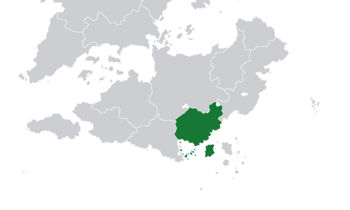Azure Coast
The Azure Coast République Souveraine de la Côte d'Azur | |
|---|---|
| Motto: Terre du Peuple de la Sainte Mère. | |
| Anthem: Bannière de la Découverte | |
 | |
| Capital | Sartoux |
| Largest city | Sainte-Genevieve |
| Official languages | Gaullican |
| Ethnic groups | |
| Demonym(s) | Azuric Azurenne |
| Government | Federal Constitutional Parliamentary Republic |
• President | Rémy Soyer |
• Premier | Céleste Auberjonois |
| Legislature | Le Grand Conseil |
| History | |
• Colonial Era | 1560-1934 CE |
• Independence | 1934-1937 CE |
• Azuric Civil War | 1937-1947 CE |
• Military Rule | 1947-1973 CE |
• Blue Revolution | 1973-1975 CE |
• New Republic | 1975 CE-Present |
| Area | |
• Total | 1,042,343.68 km2 (402,451.14 sq mi) |
| Population | |
• 2020 census | 22,575,970 |
• Density | 21.65/km2 (56.1/sq mi) |
| GDP (PPP) | 2020 estimate |
• Total | $458.29 Billion |
• Per capita | $20,300 |
| GDP (nominal) | 2020 estimate |
• Total | $229.14 Billion |
• Per capita | $10,150 |
| Currency | Azuric Coronat (Ꞓ) (AZC) |
| Date format | mm-dd-yy |
| Driving side | right |
The Azure Coast, formally known as the Sovereign Republic of the Azure Coast (Gaullican; République Souverain de la Côte d'Azur), sometimes known by its Gaullican shortform Côte d'Azur is a sovereign country and federal constitutional parliamentary republic located in southern Asteria Inferior. A former colony of Gaullica, the Azure Coast is bordered to its north across the Southern Asterian Range by Satucin, and to its west by Belmonte. The national population of just over 22.5 million are unevenly clustered around the verdant coastal regions; the more isolated interior see a fraction of the coastal plain's population density. A developing economy and middle power on the continent, its capital city is Sartoux, while its largest city, busiest port and central economic and financial center is Sainte-Genevieve.
Human presence along the southern front of the Southern Asterian Range dates back roughly 50,000 years; nomadic hunter-gatherers were the first to arrive, likely from the north through the Sythes-Juoda Basin along game trails through to the mountain passes. The Tupi and Guarani peoples, moving east from present-day Belmonte are thought to have pushed the nomadic Kawésqar and Yahgan peoples further east into grounds less amenable for foraging but ripe for hunting. The coincidence of the development of agriculture and the first permanent settlements around 10,000 years ago would establish the basis for aboriginal Azurenne presence until the arrival of explorers from the Gaullican Empire under Joseph de Salers in 1560 CE. Initially seeking to circumnavigate Asteria Inferior and fine a safer route through to the other side of the mountains, Gaullican presence would only increase following the discovery of diamonds near present-day Sainte-Matisse. The first permanent settlement was founded by the colony’s first governor, Étienne Montluçon on the River Thauvin, near the modern-day city of Souchon (he would also go on to found a trade station and depot further upriver named [[Sartoux|Rendezvous}}, the present Sartoux.
The proselytization of the country over the ensuing 300 years established fervent love for the Gaullican homeland among the colony’s Euclean populations, though the native population and those of mixed ancestry remained less friendly. Independence came as a consequence of the Great War, when the colony was forcibly excised from Gaullica’s control in 1934. The Azurenne Civil War (1937-1947) that followed would see the rise of the councilist-socialist Vague Rouge face off against conservative Catholics and those seeking to build a modern republic, eventually commanded by Alban Serreau. The victory of the pro-democratic forces under Serreau drove the Vague Rouge survivors into the far north, where they would continue to launch an insurgency with guerrilla tactics for the next several decades. The failure of the 1950 Constitutional Convention to draft a new government led Serreau and his remaining military forces to seize the capital . For the next 23 years, Serreau would reign as a military dictator over the country, imposing his will until students and laborers rose up in protest, driving him from office into exile in the 1973 Blue Revolution. The new constitution for Côte d'Azur was approved in 1975, with the first free elections in the country’s history held in October of that year.
The Azure Coast is a developing economy with a rising HDI and declining poverty rate. The country has begun to engage in a modernization effort to restructure colonial infrastructure to better suit the new economic sectors such as petroleum extraction and refinement, precious minerals and commercial agriculture, including widespread wine and liquor production. Since the Blue Revolution in 1973, a growing services economy has begun to bring increasing wealth to the people, growing apace with a small but burgeoning technology industry. Tourism and gambling has become a major part of the economy along the southern and southwestern coastal areas, the Grand Strand. However, a significant income gap has led to rising inequality between the wealthy coast and the poorer interior; lesser infrastructure in the interior has also played a major role in slowing economic development of the country’s natural resources.
Largely isolationist from Asteria Inferior and global politics since the end of the Great War, Côte d'Azur has mostly shied away from participation in multinational organizations; it is however a member of the Asteria Inferior Common Market (ASTCOM). Following the election of its first female premier in 2021, the country has began exploring its role in the greater region and abroad.

